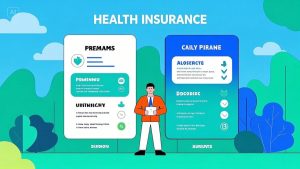
{"aigc_info":{"aigc_label_type":0,"source_info":"dreamina"},"data":{"os":"web","product":"dreamina","exportType":"generation","pictureId":"0"},"trace_info":{"originItemId":"7494245836528880957"}}
Health care is a fundamental need, yet for many families, the cost of insurance can feel overwhelming. Fortunately, there are numerous low-cost health insurance options for low-income families that offer essential coverage, peace of mind, and protection against financial hardship. Understanding the available plans, eligibility criteria, and application process can help you secure the care your family deserves—without breaking the bank.
In this detailed guide, we’ll explore affordable health insurance options for low-income households, covering everything from Medicaid and CHIP to ACA marketplace subsidies and nonprofit programs.
Table of Contents
- Introduction: The Importance of Affordable Health Insurance
- Understanding Low-Income Health Insurance
- 2.1 What Counts as Low Income?
- 2.2 Why Coverage Matters
- Top Low-Cost Health Insurance Programs
- 3.1 Medicaid
- 3.2 CHIP (Children’s Health Insurance Program)
- 3.3 ACA Marketplace Subsidies
- 3.4 Short-Term Plans (Use with Caution)
- How the Affordable Care Act Supports Low-Income Families
- 4.1 Premium Tax Credits
- 4.2 Cost-Sharing Reductions (CSRs)
- Eligibility Criteria for Low-Income Health Insurance
- 5.1 Based on Household Income
- 5.2 Family Size and Location
- 5.3 Immigration Status
- How to Apply for Low-Cost Health Insurance
- 6.1 Healthcare.gov or State Marketplaces
- 6.2 Medicaid or CHIP Enrollment
- 6.3 Community Health Navigators and Assistance Programs
- What These Plans Typically Cover
- 7.1 Doctor Visits and Preventive Care
- 7.2 Hospitalization and Emergency Services
- 7.3 Prescription Drugs
- 7.4 Mental Health and Substance Use
- 7.5 Maternity and Newborn Care
- Free or Discounted Clinics as a Backup
- How to Lower Costs Even Further
- 9.1 Use of Federally Qualified Health Centers (FQHCs)
- 9.2 Generic Medications
- 9.3 Medical Debt Forgiveness Programs
- Top Health Insurance Providers Offering Low-Cost Options
- 10.1 Molina Healthcare
- 10.2 Kaiser Permanente
- 10.3 Blue Cross Blue Shield (Local Plans)
- 10.4 Centene (Ambetter)
- Understanding Health Insurance Terms: Premiums, Deductibles & Copays
- Common Mistakes to Avoid When Choosing a Plan
- Real-Life Success Stories
- FAQs
- 14.1 What’s the income limit for Medicaid?
- 14.2 How do I apply for CHIP for my child?
- 14.3 Are there plans that cost $0/month?
- 14.4 What if my income changes mid-year?
- 14.5 Can immigrants qualify for low-cost coverage?
- Conclusion: Health Security for Every Family
1. Introduction: The Importance of Affordable Health Insurance
Health insurance protects families from devastating medical bills and ensures access to vital care. For low-income households, the challenge lies in finding affordable coverage that still provides adequate benefits. Fortunately, federal and state programs, along with nonprofit and community options, offer several pathways to quality care at reduced or no cost.
2. Understanding Low-Income Health Insurance
2.1 What Counts as Low Income?
“Low income” is typically defined relative to the Federal Poverty Level (FPL), which varies based on household size. In 2024:
| Household Size | 100% FPL | 138% FPL | 400% FPL |
|---|---|---|---|
| 1 person | $14,580 | $20,120 | $58,320 |
| 2 people | $19,720 | $27,214 | $78,880 |
| 4 people | $30,000 | $41,400 | $120,000 |
2.2 Why Coverage Matters
Without insurance, families often delay care, leading to worse health outcomes and higher future costs. Low-cost insurance can break the cycle by ensuring preventive care and protecting against emergencies.
3. Top Low-Cost Health Insurance Programs
3.1 Medicaid
Medicaid is the primary health insurance option for low-income families. Funded jointly by federal and state governments, it provides comprehensive coverage with little to no cost.
Key Benefits:
- Free or low-cost doctor visits, hospital stays, and prescriptions
- Includes mental health, maternity care, and pediatric services
- No monthly premium for most enrollees
3.2 CHIP (Children’s Health Insurance Program)
CHIP offers low-cost health coverage to children in families that earn too much for Medicaid but can’t afford private insurance.
Features:
- Low copays
- Coverage for vision, dental, immunizations, and more
- Often includes pregnant women in some states
3.3 ACA Marketplace Subsidies
Under the Affordable Care Act, families can buy insurance via Healthcare.gov or state exchanges, with financial assistance based on income.
- Premium tax credits lower your monthly payment
- Cost-sharing reductions reduce out-of-pocket costs
- Families under 150% FPL may qualify for $0/month Bronze or Silver plans
3.4 Short-Term Plans (Use with Caution)
Short-term insurance is inexpensive but often does not cover pre-existing conditions, mental health, or maternity care. Use only as a last resort or during temporary gaps in coverage.
4. How the Affordable Care Act Supports Low-Income Families
4.1 Premium Tax Credits
Available for households earning between 100% and 400% of the FPL, these credits lower your monthly premiums. In 2024, the American Rescue Plan enhancements continue, extending subsidies beyond 400% FPL.
4.2 Cost-Sharing Reductions (CSRs)
CSRs lower your deductible, copay, and coinsurance amounts when you enroll in a Silver-level plan and earn between 100% and 250% of the FPL.
5. Eligibility Criteria for Low-Income Health Insurance
5.1 Based on Household Income
Your Modified Adjusted Gross Income (MAGI) determines your eligibility. Tax returns, pay stubs, or bank statements are used as proof.
5.2 Family Size and Location
Eligibility varies by state. For example, in California, families earning up to 138% FPL qualify for Medicaid, while New York extends coverage to 200%.
5.3 Immigration Status
- Qualified immigrants (e.g., green card holders, refugees) may qualify after a 5-year wait.
- Children and pregnant women may qualify immediately in some states.
- Emergency Medicaid is available regardless of status for life-threatening situations.
6. How to Apply for Low-Cost Health Insurance
6.1 Healthcare.gov or State Marketplaces
Visit https://www.healthcare.gov and:
- Create an account
- Submit income and household info
- Compare subsidized plans
6.2 Medicaid or CHIP Enrollment
- Apply anytime of the year
- Visit your state’s Medicaid site
- Coverage often starts the month of application
6.3 Community Health Navigators and Assistance Programs
Free help is available through:
- Community clinics
- Nonprofit orgs (e.g., Enroll America, United Way)
- State health departments
7. What These Plans Typically Cover
7.1 Doctor Visits and Preventive Care
Annual checkups, vaccinations, and screenings are covered at no cost in most plans.
7.2 Hospitalization and Emergency Services
Medicaid and ACA plans must cover emergency room visits, surgeries, and inpatient care.
7.3 Prescription Drugs
Most programs offer a drug formulary. Generic drugs are usually free or very low-cost.
7.4 Mental Health and Substance Use
Coverage includes:
- Therapy
- Psychiatric services
- Addiction treatment
7.5 Maternity and Newborn Care
From prenatal visits to postnatal care, low-income plans offer comprehensive maternal health services.
8. Free or Discounted Clinics as a Backup
If you’re uninsured or underinsured:
- Federally Qualified Health Centers (FQHCs) provide sliding-scale care
- Planned Parenthood offers reproductive health services
- Local health departments may offer vaccinations, family planning, and STD testing
9. How to Lower Costs Even Further
9.1 Use of FQHCs
FQHCs provide primary care, dental, and behavioral services, even for uninsured families.
9.2 Generic Medications
Ask your doctor or pharmacist about low-cost generics, which can be up to 80% cheaper.
9.3 Medical Debt Forgiveness Programs
Many hospitals offer charity care or financial assistance. Always ask for options if you receive a large bill.
10. Top Health Insurance Providers Offering Low-Cost Options
10.1 Molina Healthcare
Focuses on Medicaid and CHIP with affordable, user-friendly plans.
10.2 Kaiser Permanente
Offers high-quality care with Medicaid plans in select states.
10.3 Blue Cross Blue Shield (Local Plans)
Most BCBS companies offer ACA plans with subsidies in every state.
10.4 Centene (Ambetter)
Offers low-cost marketplace plans with large provider networks.
11. Understanding Health Insurance Terms: Premiums, Deductibles & Copays
| Term | Definition |
|---|---|
| Premium | Monthly payment to keep your insurance active |
| Deductible | Amount you pay before insurance kicks in |
| Copay | Fixed amount paid for visits or medications |
| Coinsurance | Percentage of costs you share after deductible is met |
| Out-of-Pocket Max | Max amount you pay per year before insurance covers 100% |
12. Common Mistakes to Avoid When Choosing a Plan
- ❌ Picking the lowest premium without checking deductibles
- ❌ Not applying for Cost-Sharing Reductions
- ❌ Missing open enrollment deadlines
- ❌ Assuming you’re ineligible without checking current income levels
13. Real-Life Success Stories
Monica, a single mom in Texas:
“My kids were covered through CHIP, and I got a Silver plan for $10/month. Last year, my daughter had surgery, and we paid almost nothing. It saved us thousands.”
Jamal, a part-time worker in New York:
“I was between jobs. Medicaid kept me covered when I had a health scare. No bills, no stress.”
14. FAQs
14.1 What’s the income limit for Medicaid?
Varies by state. In most states, it’s 138% of FPL. Use Healthcare.gov to check.
14.2 How do I apply for CHIP for my child?
Visit https://www.insurekidsnow.gov or call 1-877-KIDS-NOW.
14.3 Are there plans that cost $0/month?
Yes, with tax credits, many Bronze and Silver plans have $0 premiums for families under 150% of FPL.
14.4 What if my income changes mid-year?
Report changes to the marketplace to adjust your subsidy and avoid overpayment.
14.5 Can immigrants qualify for low-cost coverage?
Yes, depending on immigration status and length of residency. Children often qualify immediately.
15. Conclusion: Health Security for Every Family
Access to affordable healthcare is not a luxury—it’s a right. Whether through Medicaid, CHIP, ACA plans, or local programs, low-income families have options. With the right coverage, you can prioritize your family’s health, avoid debt, and live with peace of mind.
Explore your eligibility, compare plans, and get covered. Because your health—and your family’s future—are worth it.





